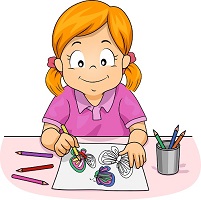Many experts believe that children are innately creative. As adults, our role can be to support and encourage the expression of that innate creativity. Just like with any other area of child development, there are many ways to do this.
Expressing creativity is a combination of formal “training” as well as innovation and free form expression.
Creativity requires a mindset of openness, non-judgement and curiosity.
It’s about the process of expression, not the end product.
Creative expression can support other areas of development (like language, social-emotional skills, gross motor development) but it primarily fulfills a human need. Creative expression is how we let our inside feelings (many times feelings that we can’t put into words) out into the world. It is a process that helps us connect to our own inner selves and with others. Creative expression can reach across cultural and language barriers. It can entertain, educate, and heal us.
When your child is drawing or dancing or singing, remember to take joy in their unprompted, natural creative expression!
Although creativity is innate, creative expression can benefit from supportive instruction too.
You may compare it to language development:
How wonderful it feels when your child begins to babble naturally, then forms words and sentences! Adults show excitement and encouragement in the child’s growing ability to express themselves. It is pure joy–in and of itself–when your child blows their first raspberry, speaks their first words, laughs, tells their first joke.
At the same time, we begin giving children more formal tools to express language, like teaching pronunciation, recognition of letters, how to write letters and formulate complex sentences, etc.
Just like you provide formal support in language development, you can provide early support in learning the building blocks of art, music and movement.
For example:
Drawing skills
I love how art teacher Ron Mulvey talks about the “Artabet” on his website:
- If you were to teach a 3 to 5 year old to write you would start with the Alphabet.
- If you were to teach a 3 to 5 year old to count you would start with the Numbers
- If you were to teach a 3 to 5 year old to draw you would teach them the Artabet”
The “artabet” includes the “6 universal lines” that Mulvey defines as: round and round, up and down, zig zag, wiggle wiggle, dot dot.
More info: https://www.theartabet.com/what-do-i-teach-my-3-to-5-year-old-to-draw/
Drawing skills are specific skills that can be used for many things in addition to artistic expression. For example, drawing skills can help communicate ideas with visual representations, hone observational skills, and conceptualize spatial relations.
If your child pushes back against learning more formal tools–that’s okay.
Follow their lead. Look for cues from them that they are craving more tools. For example, your child might say, “I can’t draw it–you draw it for me, Dada!” That is a child-directed opening to show how you use lines and shapes as you draw.
You can use some of Ron Mulvey’s tools on his website, but there are many other things you can do to support the desire for realistic drawing skills. For example, instead of drawing a flower, use your finger to outline the petals of a flower and ask your child to copy what your finger does.
Of course, if your child shows more interest in creative expression through music or dance, then by all means –follow their lead!
Basic skills in all areas of creative expression can be learned. How we personally choose to express our inner selves creatively comes from inside us AND the supportive environment and opportunities provided to us in our early years.

